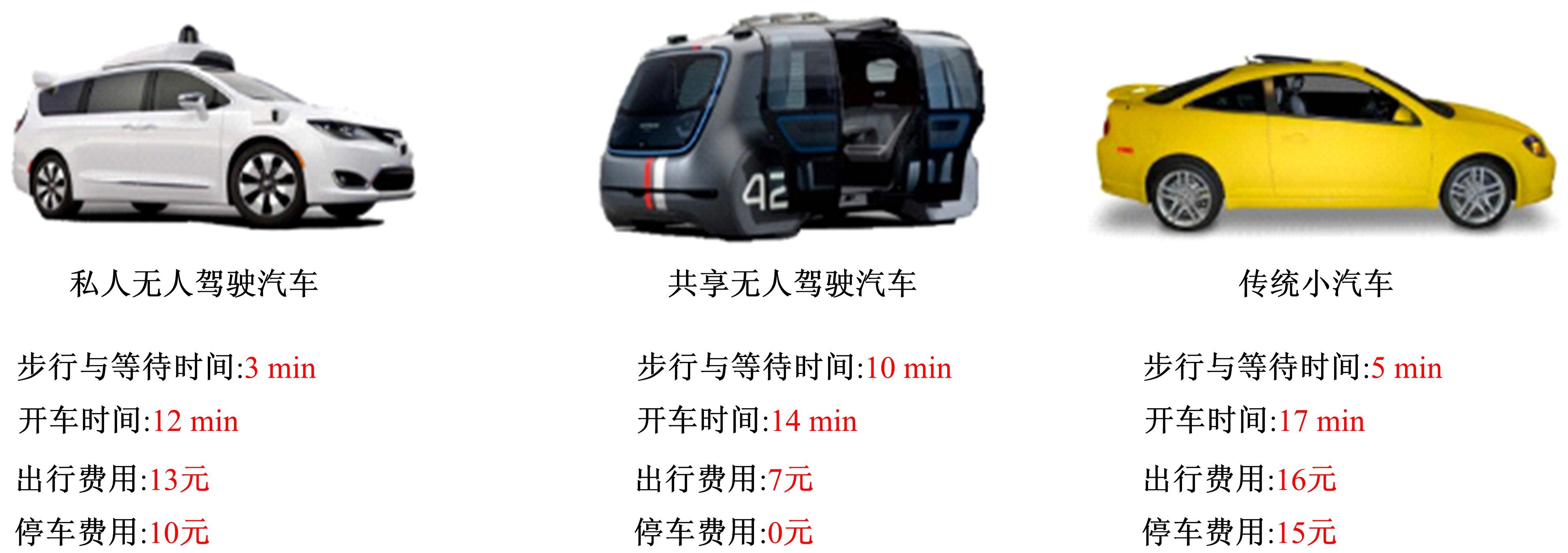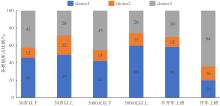Journal of Jilin University(Engineering and Technology Edition) ›› 2021, Vol. 51 ›› Issue (4): 1261-1268.doi: 10.13229/j.cnki.jdxbgxb20200390
Travelers′ choice behavior of autonomous vehicles based on latent class
Zhi-wei LIU1( ),Jian-rong LIU2(
),Jian-rong LIU2( ),Wei DENG3
),Wei DENG3
- 1.School of Civil Engineering and Architecture,Wuhan Polytechnic University,Wuhan 430023,China
2.School of Civil Engineering and Transportation,South China University of Technology,Guangzhou 510640,China
3.School of Transportation,Southeast University,Nanjing 210096,China
CLC Number:
- U121
| 1 | Molin E, Mokhtarian P, Kroesen M. Multimodal travel groups and attitudes: a latent class cluster analysis of Dutch travelers[J]. Transportation Research Part A: Policy and Practice, 2016, 83(1): 14-29. |
| 2 | Zhang X, Guan H, Zhu H, et al. Analysis of travel mode choice behavior considering the indifference threshold[J]. Sustainability, 2019, 11(19): 1-23. |
| 3 | Boxall P C, Adamowicz W L. Understanding heterogeneous preferences in random utility models: a latent class approach[J]. Environmental and resource economics,2002, 23(4): 421-446. |
| 4 | Sarrias M, Daziano R. Multinomial Logit models with continuous and discrete individual heterogeneity in R: the GMNL package[J]. Journal of Statistical Software,2017, 79(2): 1-46. |
| 5 | Ardeshiri A, Vij A. Lifestyles, residential location, and transport mode use: a hierarchical latent class choice model[J]. Transportation Research Part A: Policy and Practice,2019, 126(10): 342-359. |
| 6 | 刘建荣,刘志伟. 基于出行者潜在类别的公交出行行为研究[J]. 华南理工大学学报:自然科学版, 2019, 47(6):119-126. |
| Liu Jian-rong, Liu Zhi-wei. Analysis of bus users' behavior based on latent class[J]. Journal of South China University of Technology (Natural Science Edition), 2019, 47(6): 119-126. | |
| 7 | Ben-Akiva M, Mcfadden D, Gärling T, et al. Extended framework for modeling choice behavior[J]. Marketing Letters, 1999, 10(3): 187-203. |
| 8 | 景鹏,隽志才,查奇芬. 考虑心理潜变量的出行方式选择行为模型[J]. 中国公路学报, 2014, 27(11): 84-92, 108. |
| Jing Peng, Zhi-cai Juan, Zha Qi-fen. Incorporating psychological latent variables into travel mode choice model[J]. China Journal of Highway Transportation, 2014, 27(11): 84-92, 108. | |
| 9 | Davis F D, Bagozzi R P, Warshaw P R. User acceptance of computer technology: a comparison of two theoretical models[J]. Management science, 1989, 35(8): 982-1003. |
| 10 | Venkatesh V, Davis F D. A model of the antecedents of perceived ease of use: development and test[J]. Decision Sciences, 1996, 27(3): 451-481. |
| 11 | Mou J, Shin D, Cohen J F. Trust and risk in consumer acceptance of e-services[J]. Electronic Commerce Research, 2016,16(1):141. |
| 12 | Bansal P, Kockelman K M, Singh A. Assessing public opinions of and interest in new vehicle technologies: an Austin perspective[J]. Transportation Research Part C: Emerging Technologies, 2016, 67(6): 1-14. |
| 13 | Train K E. EM algorithms for nonparametric estimation of mixing distributions[J]. Journal of Choice Modelling, 2008, 1(1): 40-69. |
| 14 | Pacifico D, Yoo H I. Lclogit: a Stata command for fitting latent-class conditional Logit models via the expectation-maximization algorithm[J]. The Stata Journal, 2013, 13(3): 625-639. |
| 15 | Panagiotopoulos I, Dimitrakopoulos G. An empirical investigation on consumers' intentions towards autonomous driving[J]. Transportation Research Part C: Emerging Technologies, 2018, 95(10): 773-784. |
| 16 | Yáñez M F, Raveau S, Ortúzar J D D. Inclusion of latent variables in mixed Logit models: modelling and forecasting[J]. Transportation Research Part A: Policy and Practice,2010, 44(9): 744-753. |
| 17 | Wang J, Wang X. Structural Equation Modeling: Applications Using Mplus[M]. Chichester: John Wiley & Sons, 2012. |
| [1] | Wei-xiong ZHA,Qi-yan CAI,Jian LI,Li-xin YAN. Optimization of offset of urban arterial signal coordination under condition of vehicle entry and exit on side road [J]. Journal of Jilin University(Engineering and Technology Edition), 2021, 51(2): 565-574. |
| [2] | LUAN Xin, DENG Wei, CHENG Lin, CHEN Xin-yuan. Mixed Logit model for understanding travel mode choice behavior of megalopolitan residents [J]. 吉林大学学报(工学版), 2018, 48(4): 1029-1036. |
| [3] | LI Zhi-hui, HU Yong-li, ZHAO Yong-hua, MA Jia-lei, LI Hai-tao, ZHONG Tao, YANG Shao-hui. Locating moving pedestrian from running vehicle [J]. 吉林大学学报(工学版), 2018, 48(3): 694-703. |
| [4] | LI Wen-ping,YANG Jing,ZHANG Jian-pei,YIN Gui-sheng. CCA-based algorithm for personalized privacy preservation in trajectory [J]. 吉林大学学报(工学版), 2015, 45(2): 630-638. |
| [5] | SUN Yi-xuan,SHAO Chun-fu,YUE Hao,ZHU Liang. Urban traffic accident severity analysis based on sensitivity analysis of support vector machine [J]. 吉林大学学报(工学版), 2014, 44(5): 1315-1320. |
| [6] | DONG Hong-hui,SUN Xiao-liang,JIA Li-min,QIN Yong. Multimode traffic volume prediction model [J]. 吉林大学学报(工学版), 2011, 41(03): 645-649. |
| [7] | WANG Dian-hai,QI Hong-sheng. Road travel time under signal control [J]. 吉林大学学报(工学版), 2010, 40(03): 655-0660. |
| [8] | LIU Yan,GAO Qing,HUANG Yong,Yü Ming,ZHANG Zhong-jin. Seasonal running performance in hydronic ice-snow melting on road by using the earth energy [J]. 吉林大学学报(工学版), 2010, 40(01): 72-0076. |
| [9] | JIANG Gui-yan,WU Chao-teng. Link segmenting model of road network for the travel time collection based on GPS [J]. 吉林大学学报(工学版), 2009, 39(增刊2): 177-0181. |
| [10] | Jiang Guiyan, Zheng Zuduo, Bai Zhu, Dai Leilei, Zhao Jiaqi. Simulationbased assessment of variable message signs route guidance information under congestion condition [J]. 吉林大学学报(工学版), 2006, 36(02): 183-0187. |
| [11] | YANG Zhaosheng, YANG Qingfang, FENG Jinqiao. Combined time-space average speed information fusion algorithm and its application [J]. 吉林大学学报(工学版), 2004, (4): 675-678. |
| [12] | YANG Zhihong, YANG Zhaosheng, YU Dexin, CHEN Lin. Travel time prediction method based on Malcov queuing model [J]. 吉林大学学报(工学版), 2004, (4): 671-674. |
|
||



